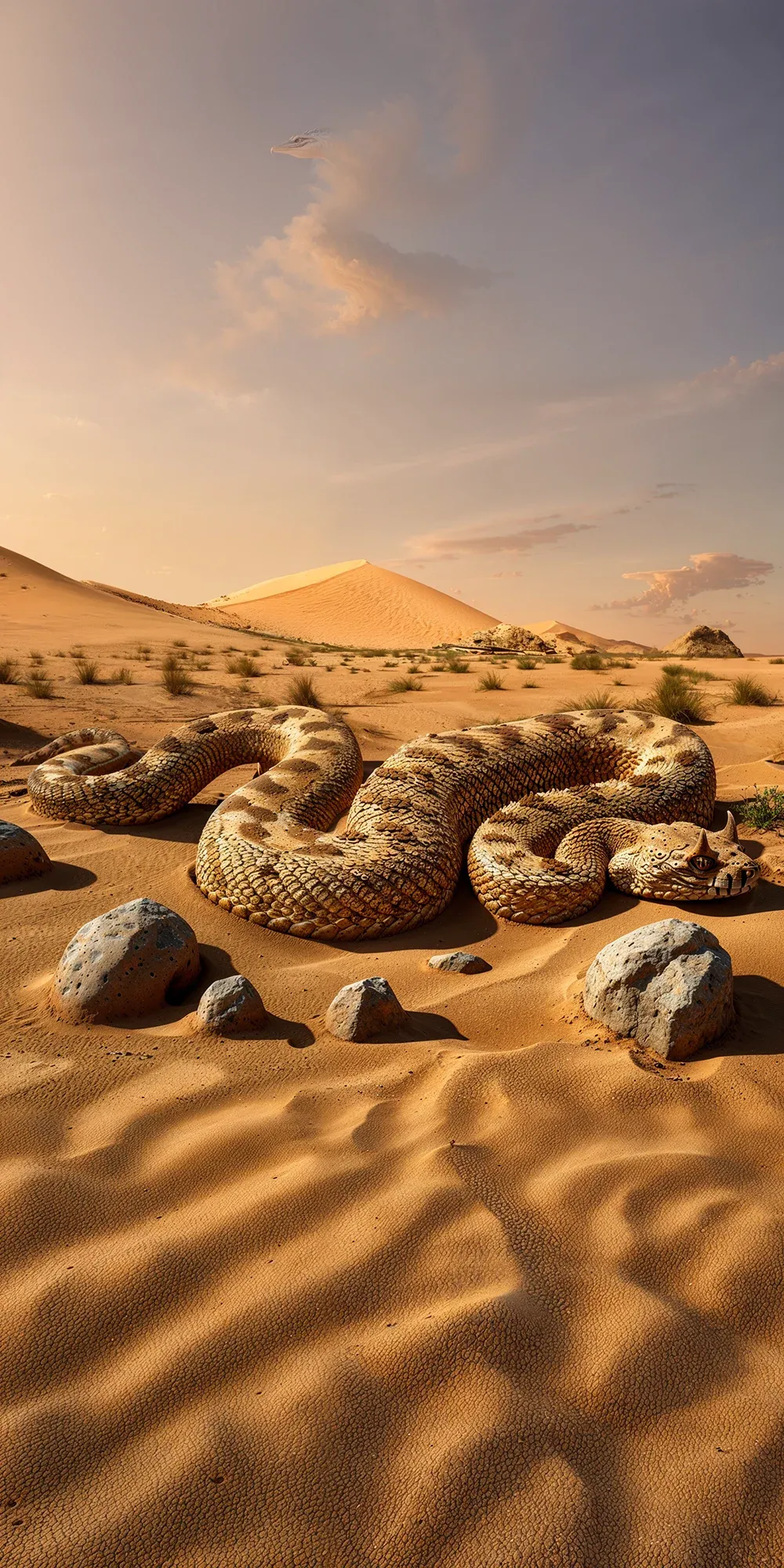The Sand Viper
The Sand Viper, also known as the Cerastes vipera, is a venomous snake found in sandy deserts of North Africa and the Middle East. It has a characteristic horn-like scale above each eye, which helps it bury itself partially in the sand while waiting for prey. Their yellowish-brown coloration provides excellent camouflage in their sandy habitat. Sand Vipers are known for their ambush hunting style, striking quickly and accurately when prey comes within striking distance.

| Sand Viper | |
|---|---|
| Size | 18 inches (45 cm) |
| Weight | 0.5 lbs (0.23 kg) |
| Speed | 50mph (80km/h) |
| Key Strength | Venomous bite |
| Biggest Weakness | Vulnerable to larger predators |
| Scientific Name | Cerastes vipera |
| Family | Viperidae |
| Habitat | Desert |
| Geography | Middle East and North Africa |
| Diet | Small rodents, lizards, birds |
| Lifespan | 10 years - 15 years |

The Sand Viper
The Sand Viper, also known as the Cerastes vipera, is a venomous snake found in sandy deserts of North Africa and the Middle East. It has a characteristic horn-like scale above each eye, which helps it bury itself partially in the sand while waiting for prey. Their yellowish-brown coloration provides excellent camouflage in their sandy habitat. Sand Vipers are known for their ambush hunting style, striking quickly and accurately when prey comes within striking distance.
Fun Fact: Sand Vipers possess a unique sideways strike that is uncommon among snakes, allowing them to efficiently catch fast-moving prey such as lizards and small mammals.
| Sand Viper | |
|---|---|
| Size | 18 inches (45 cm) |
| Weight | 0.5 lbs (0.23 kg) |
| Speed | 50mph (80km/h) |
| Key Strength | Venomous bite |
| Biggest Weakness | Vulnerable to larger predators |
| Scientific Name | Cerastes vipera |
| Family | Viperidae |
| Habitat | Desert |
| Geography | Middle East and North Africa |
| Diet | Small rodents, lizards, birds |
| Lifespan | 10 years - 15 years |
Sand Viper Matchups
We use AI to simulate matchups between the Sand Viper and other animals. Our simulation considers size, strength, and natural predatory behaviors to determine the most likely outcome.
Sand Viper: Diet, Predators, Aggression, and Defensive Behaviors
What do Sand Vipers eat?
Sand Vipers are carnivorous snakes that primarily feed on small mammals like rodents, birds, and lizards. They are known to ambush their prey by patiently waiting in the sand and striking quickly when an unsuspecting animal comes within range.
Do Sand Vipers have any predators?
Sand Vipers have a few predators in their natural habitat, including birds of prey, large mammals, and other snakes. However, their cryptic coloration and burrowing habits help them avoid many predators. One of their main predators is the mongoose, which is known for its ability to hunt and kill snakes.
Are Sand Vipers aggressive?
Sand Vipers are generally not aggressive towards humans unless they feel threatened or cornered. They will usually try to escape rather than engage in a confrontation. However, if provoked or startled, they may strike defensively with their venomous bite.
Do Sand Vipers fight with other snakes?
Sand Vipers are solitary animals and typically do not engage in fights with other snakes unless it is for mating purposes or defending their territory. Male Sand Vipers may engage in combat with each other during the breeding season to establish dominance and access to females.
How do Sand Vipers defend themselves?
Sand Vipers have several defense mechanisms to protect themselves from predators and threats. Their primary defense is their venomous bite, which can incapacitate or kill their attacker. They also have camouflaged coloration and patterned scales that help them blend into their sandy environment, making them difficult to spot.
What is the biggest weakness of Sand Vipers in a fight?
Despite their venomous bite and defensive capabilities, Sand Vipers have a relatively small size compared to some of their predators. This makes them vulnerable to larger animals that can overpower them in a physical confrontation. Additionally, being ambush predators, they rely on surprise and stealth to catch their prey, so they may struggle in a face-to-face fight with a larger, more aggressive predator.
Fun Fact: Sand Vipers have heat-sensing pits on their head that enable them to detect the body heat of their prey, helping them locate food in the dark desert nights.
Fun Fact: Sand Vipers have a specialized scale above their eyes that acts as a shield when burrowing in the sand, protecting their sensitive eyes from irritation caused by the sandy environment.










